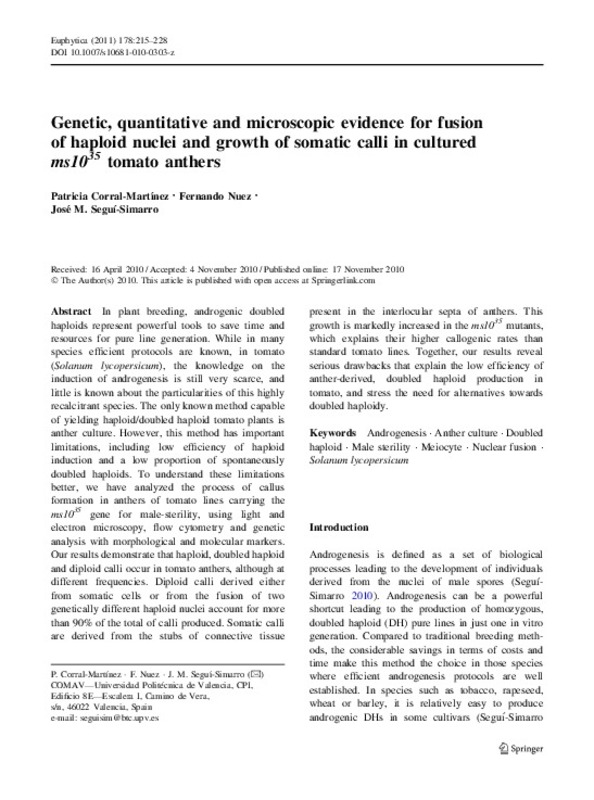Areshchenkova T, Ganal MW (1999) Long tomato microsatellites are predominantly associated with centromeric regions. Genome 42:536–544
Bal U, Abak K (2005) Induction of symmetrical nucleus division and multicellular structures from the isolated microspores of Lycopersicon esculentum Mill. Biotechnol Biotec Eq 19:35–42
Bal U, Abak K (2007) Haploidy in tomato (Lycopersicon esculentum Mill.): a critical review. Euphytica 158:1–9
[+]
Areshchenkova T, Ganal MW (1999) Long tomato microsatellites are predominantly associated with centromeric regions. Genome 42:536–544
Bal U, Abak K (2005) Induction of symmetrical nucleus division and multicellular structures from the isolated microspores of Lycopersicon esculentum Mill. Biotechnol Biotec Eq 19:35–42
Bal U, Abak K (2007) Haploidy in tomato (Lycopersicon esculentum Mill.): a critical review. Euphytica 158:1–9
Dao NT, Shamina ZB (1978) Cultivation of isolated tomato anthers. Sov Plant Physiol 25:120–126
Durand V (1981) Relations entre les gènes marqueurs aa et Wo et le gene de stérilité mâle ms35. In: Philouze J (ed) Genetique et selection de la tomate. Proceedings of the Meetings of the Eucarpia Tomato Working Group, Avignon, France, pp 225–228
FAOSTAT (2009) http://faostat.fao.org
Ferriol M, Pico B, Nuez F (2003) Genetic diversity of a germplasm collection of Cucurbita pepo using SRAP and AFLP markers. Theor Appl Genet 107:271–282
Goldberg RB, Beals TP, Sanders PM (1993) Anther development: basic principles and practical applications. Plant Cell 5:1217–1229
Gresshoff PM, Doy CH (1972) Development and differentiation of haploid Lycopersicon esculentum (tomato). Planta 107:161–170
Gulshan TMV, Sharma DR (1981) Studies on anther cultures of tomato—Lycopersicon esculentum Mill. Biol Plant 23:414–420
Ivanova SV, Dolgodvorova LI, Karlov GI, Kuchkovskaja EV (2000) Morphometric and cytogenetic characteristics of haploid tomato plants. Russ J Genetics 36:41–50
Jaramillo J, Summers WL (1990) Tomato anther callus production—solidifying agent and concentration influence induction of callus. J Am Soc Hortic Sci 115:1047–1050
Jaramillo J, Summers WL (1991) Dark-light treatments influence induction of tomato anther callus. Hortscience 26:915–916
Levenko BA, Kunakh VA, Yurkova GN (1977) Studies on callus tissue from anthers. 1. Tomato. Phytomorphology 27:377–383
Ma YH, Kato K, Masuda M (1999) Efficient callus induction and shoot regeneration by anther culture in male sterile mutants of tomato (Lycopersicon esculentum Mill. cv. First). J Jpn Soc Hortic Sci 68:768–773
Murashige T, Skoog F (1962) A revised medium for rapid growth and bioassays with tobacco tissue cultures. Physiol Plant 15:473–479
Philouze J (1974) Marker genes for Ms-32 and Ms-35 male-sterility genes in tomato. Annales De L Amelioration Des Plantes 24:77–82
Rick CM (1948) Genetics and development of nine male-sterile tomato mutants. Hilgardia 18:599–633
Seguí-Simarro JM (2010) Androgenesis revisited. Bot Rev 76:377–404
Seguí-Simarro JM, Nuez F (2005) Meiotic metaphase I to telophase II is the most responsive stage of microspore development for induction of androgenesis in tomato (Solanum Lycopersicum). Acta Physiol Plant 27:675–685
Seguí-Simarro JM, Nuez F (2007) Embryogenesis induction, callogenesis, and plant regeneration by in vitro culture of tomato isolated microspores and whole anthers. J Exp Bot 58:1119–1132
Seguí-Simarro JM, Nuez F (2008) How microspores transform into haploid embryos: changes associated with embryogenesis induction and microspore-derived embryogenesis. Physiol Plant 134:1–12
Seguí-Simarro JM, Otegui MS, Austin JR, Staehelin LA (2008) Plant cytokinesis—insights gained from electron tomography studies. In: Verma DPS, Hong Z (eds) Cell division control in plants. Springer, Berlin/Heidelberg, pp 251–287
Senatore A, Trobacher CP, Greenwood JS (2009) Ricinosomes predict programmed cell death leading to anther dehiscence in tomato. Plant Physiol 149:775–790
Sharp WR, Dougall DK (1971) Haploid plantlets and callus from immature pollen grains of Nicotiana and Lycopersicon. B Torrey Bot Club 98:219–222
Sharp WR, Raskin RS, Sommer HW (1972) The use of nurse culture in the development of haploid clones in tomato. Planta 104:357–361
Shivanna KR, Johri BM (1985) The angiosperm pollen. Structure and function. Wiley Eastern Limited, New Delhi
Shtereva LA, Zagorska NA, Dimitrov BD, Kruleva MM, Oanh HK (1998) Induced androgenesis in tomato (Lycopersicon esculentum Mill). II. Factors affecting induction of androgenesis. Plant Cell Rep 18:312–317
Smulders MJM, Bredemeijer G, RusKortekaas W, Arens P, Vosman B (1997) Use of short microsatellites from database sequences to generate polymorphisms among Lycopersicon esculentum cultivars and accessions of other Lycopersicon species. Theor Appl Genet 94:264–272
Summers WL, Jaramillo J, Bailey T (1992) Microspore developmental stage and anther length influence the induction of tomato anther callus. Hortscience 27:838–840
Touraev A, Pfosser M, Heberle-Bors E (2001) The microspore: a haploid multipurpose cell. Adv Bot Res 35:53–109
Varghese TM, Gulshan Y (1986) Production of embryoids and calli from isolated microspores of tomato (Lycopersicon esculentum Mill.) in liquid media. Biol Plant 28:126–129
Zagorska NA, Shtereva A, Dimitrov BD, Kruleva MM (1998) Induced androgenesis in tomato (Lycopersicon esculentum Mill.)—I. Influence of genotype on androgenetic ability. Plant Cell Rep 17:968–973
Zagorska NA, Shtereva LA, Kruleva MM, Sotirova VG, Baralieva DL, Dimitrov BD (2004) Induced androgenesis in tomato (Lycopersicon esculentum Mill.). III. Characterization of the regenerants. Plant Cell Rep 22:449–456
Zamir D, Jones RA, Kedar N (1980) Anther culture of male sterile tomato (Lycopersicon esculentum Mill.) mutants. Plant Sci Lett 17:353–361
[-]









